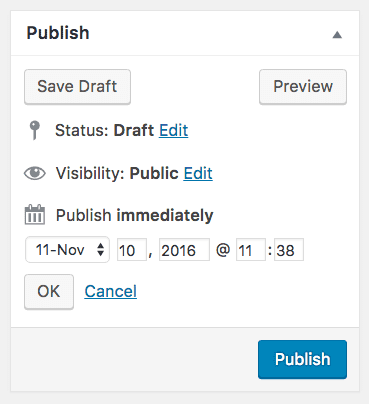Running a class blog is a great way to introduce students to website creation and to give them an opportunity to learn how to write for the web. Plenty of students who might be more reluctant to write more traditional texts could be more enthusiastic about writing blog posts that their classmates can share and comment on.
A class blog can also help you keep parents in touch with what’s going on in class – by writing posts and encouraging students to do so too, and including media such as galleries and video, you can communicate what students are learning and the activities you’ve been undertaking.
But after the initial excitement of launching your class blog has worn off, how do you and your students keep the blog updated?
In this post I’m going to give you some tips on just that. I’ll offer some guidance on establishing a blogging routine that helps you keep things fresh, and highlight some features of Edublogs and CampusPress that help you regularly publish posts even if you’re not regularly writing them.
I’ll look at these tips:
- Planning your content
- Linking to the curriculum
- Using a variety of media
- Assigning responsibility
- Scheduling content.
Planning Your Content
I’m going to assume that you’re planning to post to your class blog an average of once per week. Weekly posting is a realistic goal for most, and it’s frequent enough to give your parents, students, and visitors the feeling that they’re getting regular updates.
Instead of waiting to come up with topics for your blog each week, it’ll make things much easier if you put together a plan in advance. This way you can identify what you’re going to post about, who will write the post, and what other content you’ll need – such as images and media.
At the beginning of each semester, create a publishing plan with the topics you’re going to post to your blog about each week. If planning that far ahead is too challenging for you, do it every month or two months instead. You don’t have to identify exactly what you’ll be posting each week, but identifying a topic and the media you’ll be using is enough.

If your students (or colleagues) are also posting to your blog, share the draft plan with them and get their feedback and ideas. Make sure that everyone with responsibility for posting feels that they’ve had an input into identifying the topics you’ll be covering.
Think about how your posts can link in to what’s going on in class, which might be seasonal or related to what’s in the curriculum. And don’t worry about creating lots of content each week – some weeks a few lines in a post will be enough just to keep things up to date. Especially if you intersperse these shorter posts with longer posts and different media.
Linking to the Curriculum
Defining a blog schedule from a blank sheet of paper might seem like a daunting task. But you’ve got something you can base it on – your curriculum plan. I’m assuming that every semester your team has a curriculum plan that you use to plan lessons and topics over the course of the semester.
Your class blog can link directly to this. Identify topics for your blog that are directly related to the topics you’ll be covering in class. Each week’s blog post will supplement your students’ learning and help keep parents informed on what your students have been learning in class. You can also directly link the content of your blog to homework, for example by embedding media that students need to access at home.
This should make the process of creating a blog content plan very easy – your curriculum plan pretty much writes it for you.
Using a Variety of Media
Don’t limit your class blog posts to straightforward text-based posts: there are lots of other media you can use to add some variety and also to make use of the skills and interests of your students.
Media you can use include:
- Video – videos from external sources that you embed in your posts, maybe to supplement learning or show what you’ve been watching in class (be aware of copyright – embedding YouTube videos is normally ok) or videos that you and/or your students produce in class or as homework. These might be properly planned and produced videos or they might just be a simple capture of activities in class. Think about making videos of student presentations, class productions and other visual activities taking place in class. You could also set homework for students to complete their own video documentaries, screen casts, interviews or dramatisations.
- Photos – you can photograph your students at work or the work itself, or you can task students with producing their own photographs to supplement learning. Examples might include photographs that students take on educational trips or as part of research. Photo galleries are another visual way to show people what you’ve been up to in class. Don’t display them in isolation: include text giving some background to the photos and explaining what they’re of.
- Artwork – if your students have produced drawings, models, sculptures or other artwork, you can photograph these and add them to your blog posts. This forms a permanent record of what students have produced and showcases their talents to the outside world. Think about how you’re going to photograph them to make the best of them and encourage your students to do this to boost their photography and composition skills.
- Diagrams and illustrations – you can copy these from elsewhere (be aware of copyright) or embed any diagrams or illustrations that your students produce. For example in Science lessons, diagrams of anatomy or engineering systems can illustrate what students have been learning and be a much more efficient way of explaining things than text alone.
- Text – text is important too. This can take a variety of forms – accounts of what’s been happening in class, stories, essays, opinion pieces, letters and descriptions. In English class the blog can be a great way for students to have a outlet for their writing skills. When you’re adding text to your blog, it’s a good idea to copy this into the body of the blog instead of uploading pdfs, as this is better for accessibility.
Assigning Responsibility
Updating and managing the blog isn’t just your responsibility. Think about giving students responsibility for posting to the blog or for planning and co-ordinationg content. You might want to rotate blog responsibility between groups of students each month so everyone gets a chance, or run competitions which require students to submit content for the blog.
Our interface lets you give your students Author access to your blog, meaning that they can write posts but can’t publish them. If you have an Editor or Administrator role, you’ll be able to review their posts when they submit them and then press the Publish button.

This takes a lot of the workload off your shoulders but also gives students more of a stake in the class blog, as well as helping them to develop their content creation skills. When I encouraged the students in my code club to create their own blogs, they jumped at the chance.
If you do share responsibility, make sure everyone knows exactly what’s expected of them and when. Put in place a contingency plan so if a student can’t post when they should for some reason, someone else can do it instead. Or make sure everything’s prepared and scheduled in advance so there’s no urgency.
It could be as simple as asking students that finish a project or work in class early to write up a review of the day and publish – no planning necesary!
Scheduling Content
Your content plan already lays out when you’re going to be posting to your blog and the topics that will be covered. This helps you to manage the workload involved in posting to the blog, both for you and your students.
But there’s another feature of WordPress that makes this even easier: post scheduling.
When you create a post and have it ready for publishing you can schedule it for a future date instead of publishing it immediately. This means you can get your posts ready a few days in advance and avoid any problems that might arise from working at the last minute.
To make things even more efficient you can prepare a batch of posts at once and then schedule them to be published at future dates that are regularly spaced apart. So you might identify a topic that the class will post about for a month, for example, then have all of your students submit their content by the end of the preceding month. You can review and edit all of those posts and then schedule them to publish one by one, with a new one appearing each week.

This means you only have to block out editing and publishing time each month and makes things more efficient.
Keeping Your Blog Up to Date Needn’t Be Difficult
Keeping a blog regularly updated will increase the amount of traffic you get and keep your class blog from going stagnant. It’ll improve your Google rankings and give students and parents a useful resource to help them keep on top of what’s happening in class.
It’s also a great educational tool: if you link your blog to the curriculum and give your students plenty of opportunities to create a variety of media to include in the site, you’ll make it an even richer tool for learning and not just something to tell others what your class have been doing.
And if you are still looking for ideas to post about, check out this post on 150 Student Writing Prompts For Blogs, Digital Portfolios, Or Websites.
